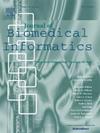Focused digital cohort selection from social media using the metric backbone of biomedical knowledge graphs
IF 4.5
2区 医学
Q2 COMPUTER SCIENCE, INTERDISCIPLINARY APPLICATIONS
引用次数: 0
Abstract
Social media data allows researchers to construct large digital cohorts — groups of users who post health-related content — to study the interplay between human behavior and medical treatment. Identifying the users most relevant to a specific health problem is, however, a challenge in that social media sites vary in the generality of their discourse. While X (formerly Twitter), Instagram, and Facebook cater to wide ranging topics, Reddit subgroups and dedicated patient advocacy forums trade in much more specific, biomedically-relevant discourse.
To filter relevant users on any social media, we have developed a general method and tested it on epilepsy discourse. We analyzed the text from posts by users who mention epilepsy drugs at least once in the general-purpose social media sites X and Instagram, the epilepsy-focused Reddit subgroup (r/Epilepsy), and the Epilepsy Foundation of America (EFA) forums. We used a curated medical terminology dictionary to generate a knowledge graph (KG) from each social media site, whereby nodes represent terms, and edge weights denote the strength of association between pairs of terms in the collected text.
Our method is based on computing the metric backbone of each KG, which yields the (sparsified) subgraph of edges that participate in shortest paths. By comparing the subset of users who contribute to the backbone to the subset who do not, we show that epilepsy-focused social media users contribute to the KG backbone in much higher proportion than do general-purpose social media users. Furthermore, using human annotation of Instagram posts, we demonstrate that users who do not contribute to the backbone are much more likely to use dictionary terms in a manner inconsistent with their biomedical meaning and are rightly excluded from the cohort of interest.
Our metric backbone approach, thus, has several benefits: it yields focused user cohorts who engage in discourse relevant to a targeted biomedical problem; unlike engagement-based approaches, it can retain low-engagement users who nonetheless contribute meaningful biomedical insights and filter out very vocal users who contribute no relevant content, it is parameter-free, algebraically principled, does not require classifiers or human-curation, and is simple to compute with the open-source code we provide.

使用生物医学知识图谱的度量主干从社交媒体中进行集中的数字队列选择。
社交媒体数据使研究人员能够构建大型数字队列——发布与健康相关内容的用户群体——来研究人类行为与医疗之间的相互作用。然而,确定与特定健康问题最相关的用户是一项挑战,因为社交媒体网站的话语普遍性各不相同。虽然X(以前的Twitter)、Instagram和Facebook迎合了广泛的话题,但Reddit的子群和专门的患者倡导论坛却在更具体的、与生物医学相关的话语上进行交易。为了过滤任何社交媒体上的相关用户,我们开发了一种通用方法,并对癫痫话语进行了测试。我们分析了用户在通用社交媒体网站X和Instagram、以癫痫为主题的Reddit子群(r/ epilepsy)和美国癫痫基金会(EFA)论坛上至少一次提到癫痫药物的帖子文本。我们使用整理好的医学术语词典从每个社交媒体站点生成知识图(KG),其中节点表示术语,边缘权重表示收集文本中术语对之间的关联强度。我们的方法是基于计算每个KG的度量主干,它产生(稀疏化的)参与最短路径的边的子图。通过比较对主干有贡献的用户子集与没有贡献的用户子集,我们发现以癫痫为重点的社交媒体用户对KG主干的贡献比例远高于一般用途的社交媒体用户。此外,使用Instagram帖子的人工注释,我们证明了不为主干做出贡献的用户更有可能以与其生物医学含义不一致的方式使用字典术语,并正确地排除在感兴趣的队列之外。因此,我们的度量骨干方法有几个好处:它产生专注的用户群,他们参与与目标生物医学问题相关的话语;与基于参与的方法不同,它可以保留低参与度的用户,尽管他们贡献了有意义的生物医学见解,并过滤掉那些没有贡献相关内容的声音非常大的用户,它是无参数的,代数原则的,不需要分类器或人工管理,并且使用我们提供的开源代码很容易计算。
本文章由计算机程序翻译,如有差异,请以英文原文为准。
求助全文
约1分钟内获得全文
求助全文
来源期刊

Journal of Biomedical Informatics
医学-计算机:跨学科应用
CiteScore
8.90
自引率
6.70%
发文量
243
审稿时长
32 days
期刊介绍:
The Journal of Biomedical Informatics reflects a commitment to high-quality original research papers, reviews, and commentaries in the area of biomedical informatics methodology. Although we publish articles motivated by applications in the biomedical sciences (for example, clinical medicine, health care, population health, and translational bioinformatics), the journal emphasizes reports of new methodologies and techniques that have general applicability and that form the basis for the evolving science of biomedical informatics. Articles on medical devices; evaluations of implemented systems (including clinical trials of information technologies); or papers that provide insight into a biological process, a specific disease, or treatment options would generally be more suitable for publication in other venues. Papers on applications of signal processing and image analysis are often more suitable for biomedical engineering journals or other informatics journals, although we do publish papers that emphasize the information management and knowledge representation/modeling issues that arise in the storage and use of biological signals and images. System descriptions are welcome if they illustrate and substantiate the underlying methodology that is the principal focus of the report and an effort is made to address the generalizability and/or range of application of that methodology. Note also that, given the international nature of JBI, papers that deal with specific languages other than English, or with country-specific health systems or approaches, are acceptable for JBI only if they offer generalizable lessons that are relevant to the broad JBI readership, regardless of their country, language, culture, or health system.
 求助内容:
求助内容: 应助结果提醒方式:
应助结果提醒方式:


